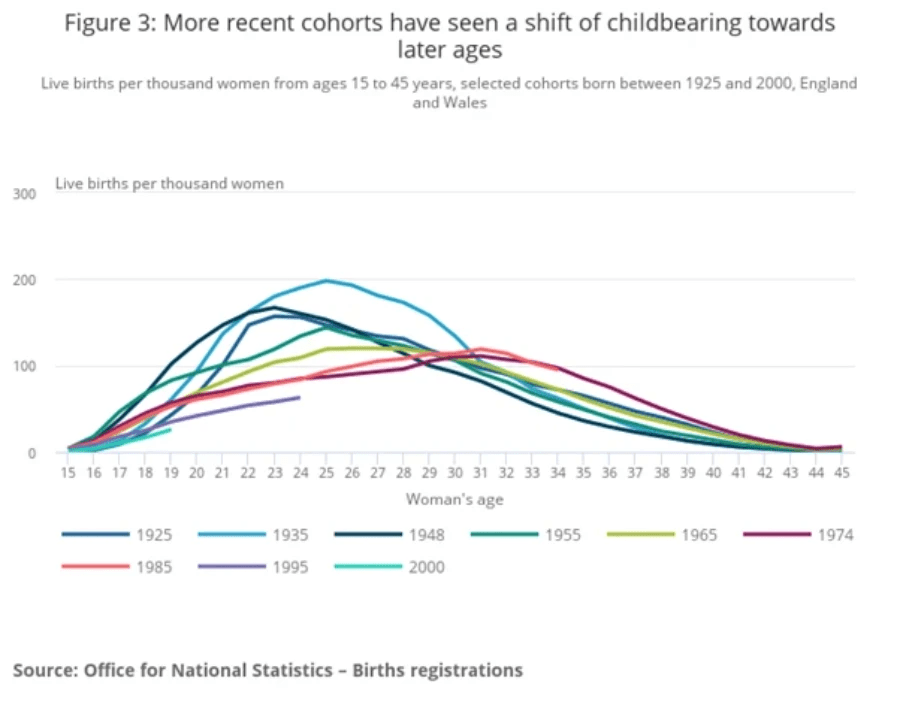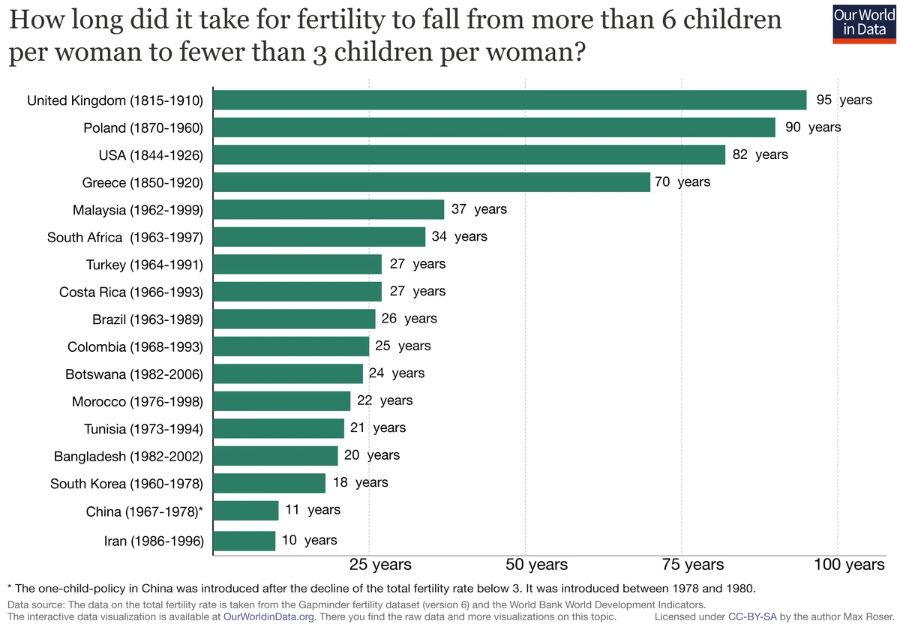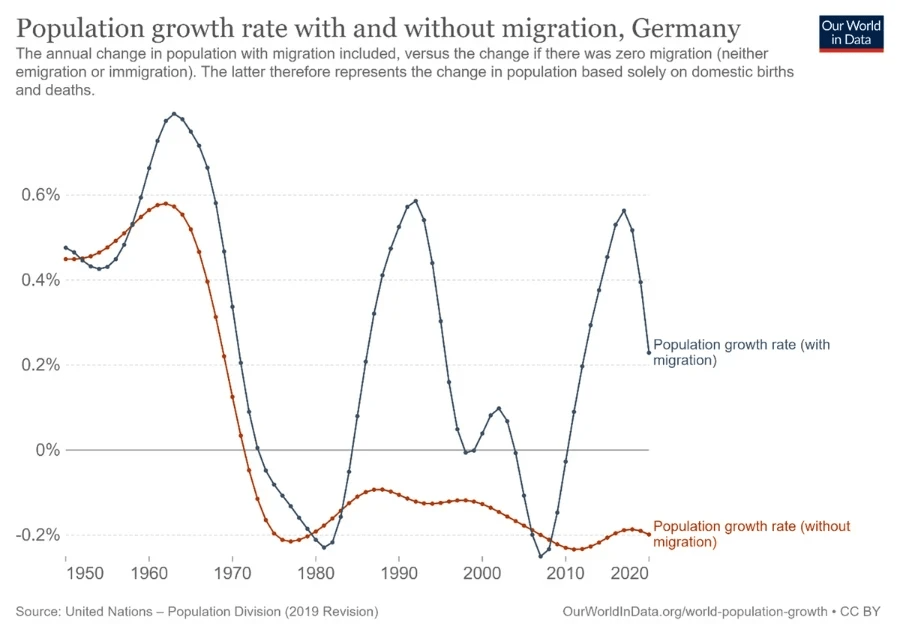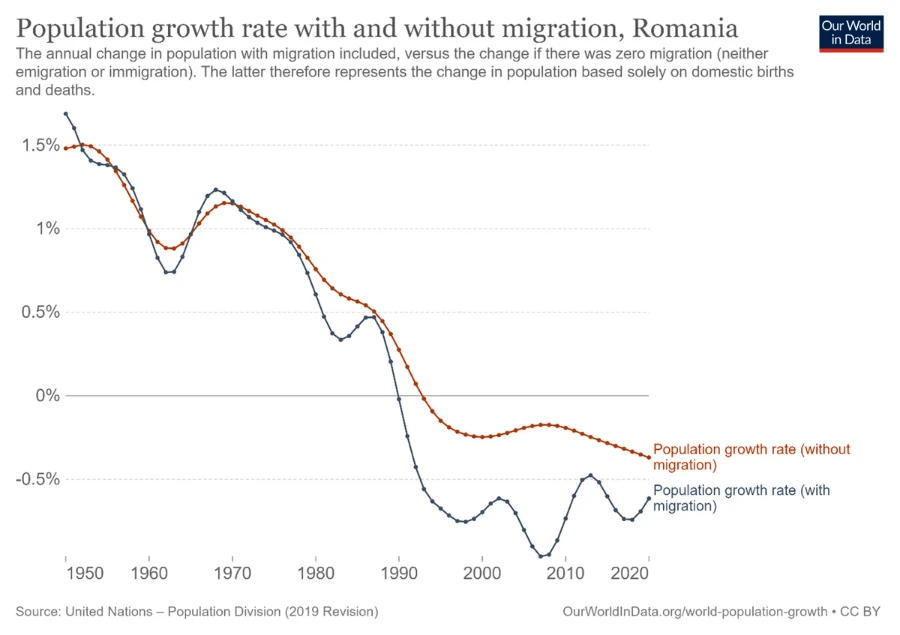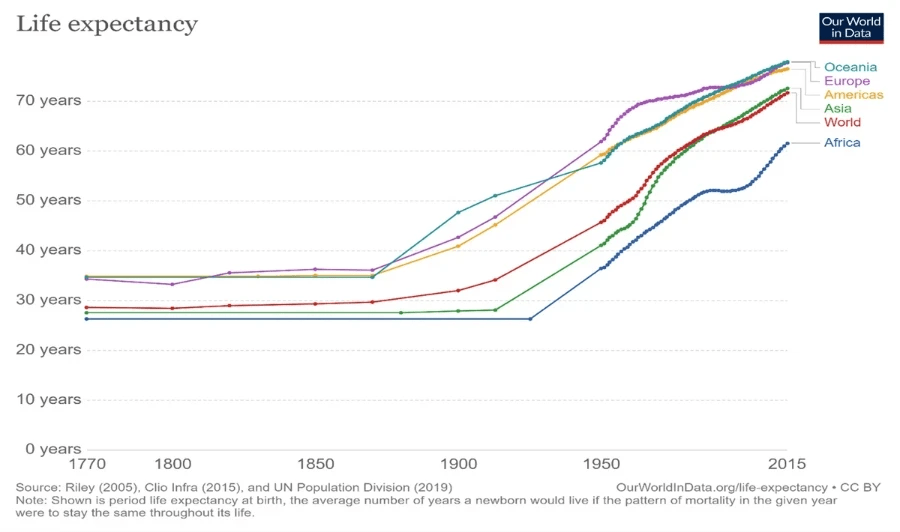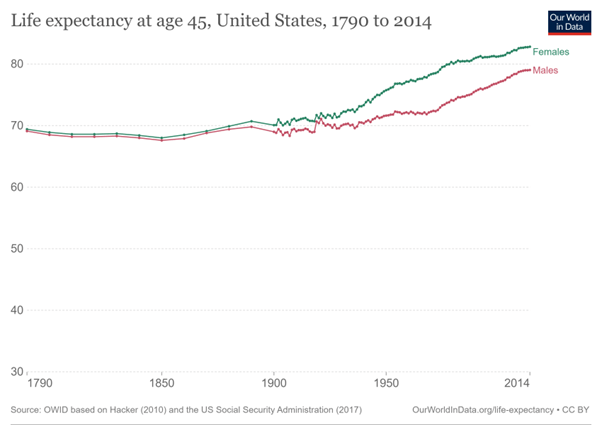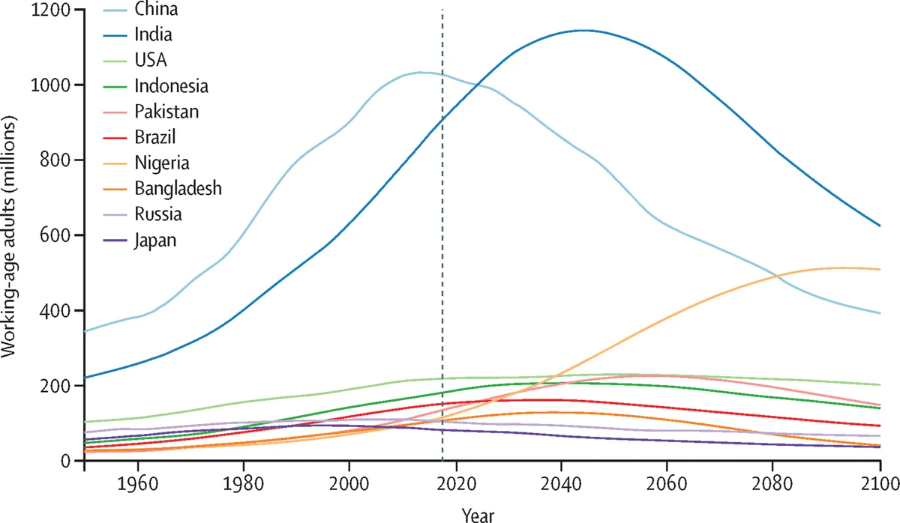
Numbers
Useful Facts and Figures
The Demographics of Ageing
THE LOGIC BOMB FOR DEMOGRAPHICS
The changes in the market are driven by an unstoppable global logic
- Women are having less children in their life time. Fertility is falling fast.
- People are living longer. Life expectancy is increasing.
- People are living healthier longer. "Healthy Ageing" is increasing.
- Fertility falls because of declines in child mortality; increases in the opportunity cost of children; cultural pressures and falling sperm count
- Life expectancy is increasing because of changes in lifestyle, the decline in accidental deaths and advances in medicine.
- Country level population also depends on migration.
To Understand Changes we need to look at Fertility, Life Expectancy, Healthy Ageing; Child Mortality; The Cost of Children; Cultural Pressures; Falling Sperm Count; Accidental death and medical advances; Migration Now read on....

Since the 1950's Fertility has fallen dramatically around the world.
The number of children a female has in their lifetime must remain above 2.1 to retain the total population. This is the replacement rate.Updated December 2022
Explaining Fertility
Scholars suggest that the initial fall in birth rates is due to the declines in child mortality. As prosperity grows, nutrition improves and with it health. Infants and children benefit first. Parents needed less births to ensure the number of adult of adult children they wanted. If prosperity drives down child mortality, and this underpins the initial decline in fertility, why does it keep declining? The economic theorists suggest that a rational parent will assess the costs and benefits of an extra child. In a world with no pensions and care for the elderly, your children are your insurance against old age poverty and loneliness. Each child puts a burden on the family until they are old enough to work, so there is a trade-off.
The post Second World War growth in state provided pensions reduces the value of a child to your old age. At the same time, the direct and opportunity costs of having a child have increased. Children need more education to ensure their employability. This increases the time they must be supported. Only then will they make an economic contribution to the family. The growing participation of women in the workforce raises the opportunity costs of children still higher.
Cultural shifts around the world complement these economic arguments. With prosperity comes the aspiration to become consumers. Food and subsidence become a smaller proportion of income. As it does individuals increase their aspirations to buy goods and services. Women still expect to have children, but they want a career and the income that provides as well. The result has been that women have delayed their first child by an average of over ten years. The delay brings down fertility.
In many parts of Europe, the “one child” family is becoming the norm. This model of “family life” and being service consumers is being spread around the world. All forms of media are affecting cultural norms and hence fertility.
Medical technology clearly helps with the innovation in, and the spread of, contraception. When child mortality starts to fall women now have much better control over their own fertility. Medicine has yet to explain the last driver of the drop in fertility. Sperm counts for men in America, Europe, Australia, and New Zealand have dropped by a half in less than forty years. Many factors are thought to be causes. These range from chemicals and pesticides to stress and obesity.
December 2021
A recent Analysis Confirms the Drop in Sperm Count.
This week that analysis was updated to include 53 different countries. The results were the same , if not worse. Sperm counts across all these countries were in decline. Not only that but since 2000 the rate of decline has increased from 1% per year to 2.5% .
December 2022

Between 1840 and 1870, the number of surviving children was virtually the same as between 1940 and 1970
In the nineteenth century, an average of five children per female were born. Sadly half of them died, leaving a family around the replacement level of 2.5 (at that time). A century later the number of children dying had plummeted and the birth rate with it. Families however continued to replace themselves. They averaged 2.2 - 2.5 children per female.For the first time half the women aged 30 were childless
The UK Office of National Statistics Reported in 2022.

The Rate of decline in Fertility is Accelerating

The German Market has depended on immigration since 1972
Population goes negative in the mid- seventies without immegration. This is when the fertility rate drops below the replacement level. Immigration returns the population to growth in the nineties and again in recent years.

Romania did not drop below replacement level fertility until 1992
In this case the drop in fertility was compounded by migration. Romania dropped below replacement level around 1993. At the same time migration accelerated. The population has been in decline ever since.

Fertility Decline Due to Declining Sperm Count
Women are having less children in their life time Shanna Swan in her book “Count Down” , highlights the impact of chemicals in the environment on both humans and animals. Lake Apopka in Florida is often used as an example. The lake is polluted with the run off of sewage and pesticides. In 1980 it also suffered a major pesticide spill from a nearby factory. Studies of the alligators in the lake, show high abnormalities in the reproductive organs. The result is that successful hatching of eggs is down to only 5% compared to benchmarks of 85% from unpolluted lakes.
There are classes of chemicals that can influence the production of hormones in humans and animals. They are in everything from plastics to pesticides. Phthalates are for example used to make plastics more pliable. They appear in food storage containers, flooring and even wallcovering. They can influence the production of testosterone. In men this reduces the sperm count and induces more misshapen sperm.
Bisphenol A is used in epoxy resins, the lining of food cans and even thermal receipt paper. It mimics oestrogen. Men with detectable levels in their urine were four times more likely to have poor sperm. The effects on women are greater. Those with high concentration in their blood have increased difficulty becoming pregnant and have an 83% chance of miscarriage in the first trimester.
The impact is not only on this generation but future generations as well. Unborn babies are susceptible to exposure at certain points in pregnancy. These same chemicals can impact their fertility, sexuality and sex drive. All this happens before they are even born. Unfortunately regulation is very poor in many parts of the world. Food and drugs are tested rigorously for negative effects before being allowed to be used. Chemicals are not.
April 2022
Fertility has a "Sell By" Date
Between the ages of 25 and 35 unprotected sex at the correct time of the month will result in pregnancy between 25% and 35% of the time. There is a 90% chance that the child will be carried full term and a 1 in 900 chance that it will have Down Syndrome.
As time goes by the numbers deteriorate, at first slowly, and then very quickly. At 35 the chances of conception drop to 20%. At 37 it drops to 15% and at 40 it is down to 10%. By 45 it is 5%. Miscarriages increase to 25% at 35 and rise to 40% at 40. Down Syndrome incidence increases from 1 in 300 at 35 to 1 in 50 at 45.
Shanna Swan, Count Down 2020
Both Sexes to Blame for Fertility Problems
Data from the clinics treating fertility problems show that 25% to 33% of the problems are due to the woman. Exactly the same proportion come because of male issues. The balance are due to the combination. Each individual could probably have a child but not with this partner. Exactly the same story is true of miscarriages. Men and women share the responsibility. With age a man’s sperm will have an increased proportion of “scrambled” DNA. As the impact on the foetus emerges the body rejects it.
Count Down, Shanna Swan 2020
Fertility Mis-Conceptions
Surveys of new mothers show that 83% had under estimated how long it would take to have a child. They were also much too optimistic about the chances of a mis-carriage. The situation gets worse as women age. At 35 they over- estimate the chance of a woman getting pregnant at 40 by 50%.
The UK data shows the current success of IVF to be 32% at 35 or under. This drops to 25% between 35 and 37, 19% between 38 and 39 and 11% for women aged 40 to 42.
Count Down Shanna Swan 2020
Sperm Counts are Dropping
In 2003 69% of applicant donors at one major US sperm bank were accepted. By 2013 that number had dropped to only 44% despite a massive recruitment campaign. Sperm counts are dropping and the health of the sperm declining
Count Down Shanna Swan 2020
Migrants
A
45% of Migrants Return Home
A recent study by the University of Washington suggests that 45% of all migrants return home. They go back to their families and “good food”. Mexican migrants within the USA provide an interesting example. There are 10.9m Mexican born individuals living in the United States. That number declined by 7% between 2010 and 2019. Prior to that between 2005 and 2010 net migration was zero. As many Mexicans went home as arrived. Even this underestimates the desire to go home. Of the 11m illegal immigrants in the USA half are from Mexico. They cannot go home without risking never being able to return. Mexicans fell to number three in the league table of US immigrants.
May 2022
Only 5.1% of the European Population are Migrants
Within Europe there are strong reverse flows. In 2019 there were an estimated 2.7m immigrants from non-EU countries. About 1.2m people emigrated from the EU to a country outside the EU. As of 2020 there were 23m citizens of non-EU countries resident in the EU, only 5.1% of the population. There were a further 13.5m migrants who had moved within the EU.
May 2022
272m Migrants in the World Today
The International Organization for Migration estimates that there are 272m migrants in the world today. These are people living in a country in which they were not born. Of these 41.3m are refugees. These are the people pushed from their country. War, famine, persecution, and natural disasters have driven them out. These numbers sadly have not been updated to include the people fleeing from the war in Ukraine.
People pushed from their countries tend to stay close. Of the 6.6m Syrian refugees, 5.3m are in Turkey, the Lebanon and Jordan. They are not beating on the doors of Europe but are in refugee camps waiting to go home.
May 2022

The Continents are Converging in Life Expectancy.
After an early lead by Europe, the Americas and Oceania the other continents are now accelerating and catching up.
After an early lead by Europe, the Americas and Oceania the other continents are now accelerating and catching up.
Updated 2019

Much of the gain has come by reducing child mortality. From 1790 US life expectancy at 45 remained at 68-70 until the middle of the last century. Overall life expectancies were low because of the children who died.
By the Turn of the Century the Working Population of China will decline by a half.
The latest forecast from the University of Washington forecasts a Chinese Working Population at the same level as 1955 by 2100

The latest forecast from the University of Washington forecasts a Chinese Working Population at the same level as 1955 by 2100
The Japanese Market is declining by 10,000 Customers a Week
In 2020, the annual births fell to 850,000 children. This was the lowest number since records began. Deaths were 1.4m , because of the ageing population. The Japanese market fell by half a million people in a single year. That is ten thousand consumers a week. That is equal to 5 full Boeing 787-8 planes leaving Tokyo Airport every day never to return.
Updated March 2022
14% of All Japanese Houses are Now Empty
Current estimates suggest that there are 8.5m empty homes in Japan. This is 14% of the total housing stock. Nomura the investment bank suggests a worst case scenario of 22m homes by 2038 as populations fall. This would be 31% of the total stock, nearly one in three. This is not concentrated in one specific area. Even in Tokyo it is estimated that one in ten houses are empty, according to the Government Survey of Land and Housing.
Japanese Housing Needs are Changing
In Japan currently 14% of all houses are empty. Certainly these are mostly in the rural areas. Urbanization has continued even though Tokyo is already a city of 36m people. However there are estimated to be 10% of houses abandoned even there. This is partly due to the idiosyncrasies of Japanese property ownership and taxes. But overlaying that is a structural shift in housing needs.
In 1960 only 16.5% of households where a single person lived. That more than doubled to over 38% in 2020. Half of the single person households were people with a job. The other half, or roughly 18% of all households, are where pensioners live alone. Young People entering the job market and retirees tend increasingly to live alone. The biggest group of men living alone are between the age of 25 and 34. Only 20% of young women live alone. But over half of all women living alone are over 75.
May 2022
Japanese Housing Needs are Changing
In Japan currently 14% of all houses are empty. Certainly these are mostly in the rural areas. Urbanization has continued even though Tokyo is already a city of 36m people. However there are estimated to be 10% of houses abandoned even there. This is partly due to the idiosyncrasies of Japanese property ownership and taxes. But overlaying that is a structural shift in housing needs.
In 1960 only 16.5% of households where a single person lived. That more than doubled to over 38% in 2020. Half of the single person households were people with a job. The other half, or roughly 18% of all households, are where pensioners live alone. Young People entering the job market and retirees tend increasingly to live alone. The biggest group of men living alone are between the age of 25 and 34. Only 20% of young women live alone. But over half of all women living alone are over 75.
May 2022
Japanese Housing Needs are Changing
In Japan currently 14% of all houses are empty. Certainly these are mostly in the rural areas. Urbanization has continued even though Tokyo is already a city of 36m people. However there are estimated to be 10% of houses abandoned even there. This is partly due to the idiosyncrasies of Japanese property ownership and taxes. But overlaying that is a structural shift in housing needs.
In 1960 only 16.5% of households where a single person lived. That more than doubled to over 38% in 2020. Half of the single person households were people with a job. The other half, or roughly 18% of all households, are where pensioners live alone. Young People entering the job market and retirees tend increasingly to live alone. The biggest group of men living alone are between the age of 25 and 34. Only 20% of young women live alone. But over half of all women living alone are over 75.
May 2022
Google delivered one hundred thousand searches per second yesterday.
On the internetlivestats.com site you can watch that number get bigger every second. Forty percent of the world’s population uses the internet on any given day. Updated May 1st,2022
3.2 Kilometres from the Check-In to the Gate
The worlds longest airport "walk", Beijing new International terminal“The World’s Longest Airport Walks”
The Australian August 2012



